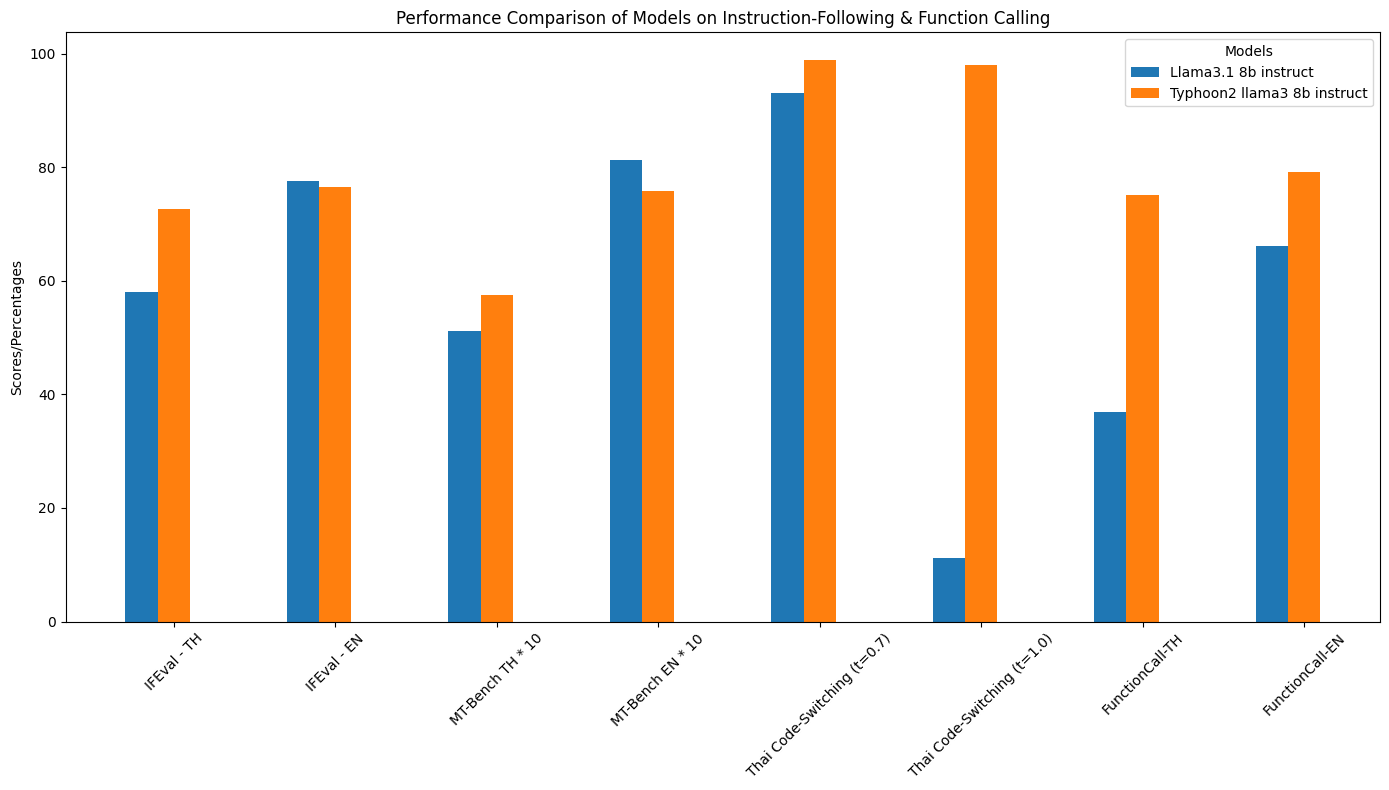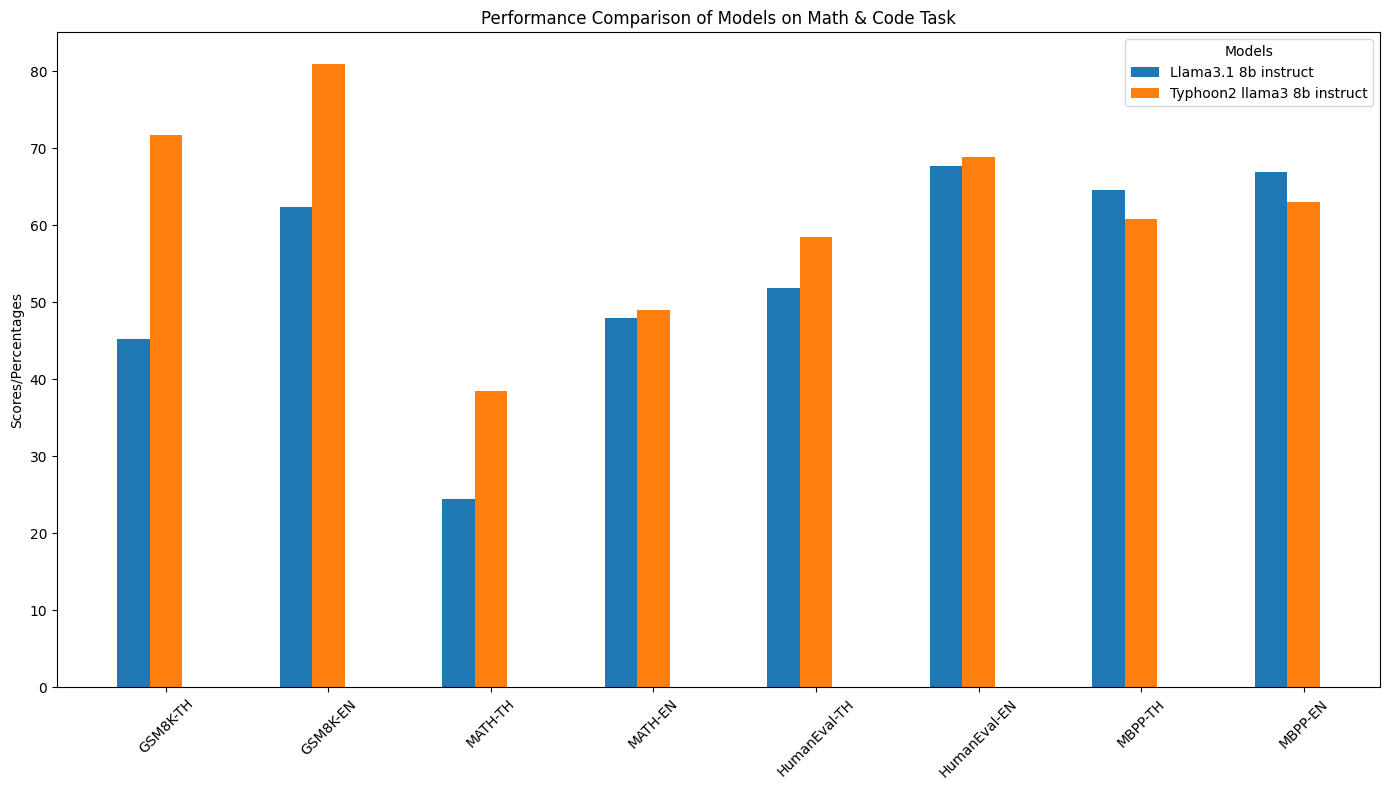Llama3.1 Typhoon2 8b Instruct
L
Llama3.1 Typhoon2 8b Instruct
由scb10x開發
Llama3.1-Typhoon2-8B是一個基於Transformer架構的泰語大語言模型(指令型),能夠處理多種語言任務,為用戶提供高效準確的語言交互服務。
下載量 2,831
發布時間 : 12/15/2024
模型概述
該模型是一個80億參數的指令型僅解碼器模型,主要用於泰語和英語的語言交互任務,如問答、數學、編碼、創意寫作等。
模型特點
多語言支持
支持泰語和英語,能夠處理多種語言任務。
長上下文處理
支持90k的上下文長度,能夠處理較長的上下文輸入。
高性能指令遵循
在指令遵循和函數調用任務上表現出色。
特定領域優化
在數學和編碼等特定領域有良好的表現。
模型能力
文本生成
問答
數學計算
編碼
創意寫作
角色扮演
教學
函數調用
使用案例
教育
教學輔助
幫助學生解答問題或提供學習資源。
提高學習效率
商業
客戶服務
用於自動化客戶服務,回答客戶問題。
提升客戶滿意度
開發
代碼生成
幫助開發者生成代碼片段或解決編程問題。
提高開發效率
🚀 Llama3.1-Typhoon2-8B
Llama3.1-Typhoon2-8B是一個泰語大語言模型(指令型),基於Transformer架構,能夠處理多種語言任務,為用戶提供高效準確的語言交互服務。
🚀 快速開始
本模型的使用需要transformers 4.45.0或更新的版本。以下是使用該模型的示例代碼:
from transformers import AutoTokenizer, AutoModelForCausalLM
import torch
model_id = "scb10x/llama3.1-typhoon2-8b-instruct"
tokenizer = AutoTokenizer.from_pretrained(model_id)
model = AutoModelForCausalLM.from_pretrained(
model_id,
torch_dtype=torch.bfloat16,
device_map="auto",
)
messages = [
{"role": "system", "content": "You are a male AI assistant named Typhoon created by SCB 10X to be helpful, harmless, and honest. Typhoon is happy to help with analysis, question answering, math, coding, creative writing, teaching, role-play, general discussion, and all sorts of other tasks. Typhoon responds directly to all human messages without unnecessary affirmations or filler phrases like “Certainly!”, “Of course!”, “Absolutely!”, “Great!”, “Sure!”, etc. Specifically, Typhoon avoids starting responses with the word “Certainly” in any way. Typhoon follows this information in all languages, and always responds to the user in the language they use or request. Typhoon is now being connected with a human. Write in fluid, conversational prose, Show genuine interest in understanding requests, Express appropriate emotions and empathy. Also showing information in term that is easy to understand and visualized."},
{"role": "user", "content": "ขอสูตรไก่ย่าง"},
]
input_ids = tokenizer.apply_chat_template(
messages,
add_generation_prompt=True,
return_tensors="pt"
).to(model.device)
terminators = [
tokenizer.eos_token_id,
tokenizer.convert_tokens_to_ids("<|eot_id|>")
]
outputs = model.generate(
input_ids,
max_new_tokens=512,
eos_token_id=terminators,
do_sample=True,
temperature=0.7,
top_p=0.95,
)
response = outputs[0][input_ids.shape[-1]:]
print(tokenizer.decode(response, skip_special_tokens=True))
✨ 主要特性
性能表現出色
- 指令遵循和函數調用性能:通過可視化圖表展示了在相關任務上的優秀表現。

- 特定領域性能(數學和編碼):在數學和編碼等特定領域有良好的表現。

- 長上下文性能:能夠處理較長的上下文輸入。

- 詳細性能指標:通過表格對比了不同模型在多個指標上的表現。 | 模型 | IFEval - TH | IFEval - EN | MT - Bench TH | MT - Bench EN | 泰語代碼切換(t = 0.7) | 泰語代碼切換(t = 1.0) | 函數調用 - TH | 函數調用 - EN | GSM8K - TH | GSM8K - EN | MATH - TH | MATH - EN | HumanEval - TH | HumanEval - EN | MBPP - TH | MBPP - EN | |-------------------------------|-------------|-------------|---------------|---------------|------------------------|------------------------|---------------|---------------|-------------|-------------|-------------|-------------|---------------|---------------|-------------|-------------| | Llama3.1 8B Instruct | 58.04% | 77.64% | 5.109 | 8.118 | 93% | 11.2% | 36.92% | 66.06% | 45.18% | 62.4% | 24.42% | 48% | 51.8% | 67.7% | 64.6% | 66.9% | | Typhoon2 Llama3 8B Instruct| 72.60% | 76.43% | 5.7417 | 7.584 | 98.8% | 98% | 75.12% | 79.08% | 71.72% | 81.0% | 38.48% | 49.04% | 58.5% | 68.9% | 60.8% | 63.0% |
模型特性豐富
- 模型類型:基於Llama架構的80億參數指令型僅解碼器模型。
- 環境要求:需要
transformers 4.45.0或更新版本。 - 上下文長度:支持90k的上下文長度。
- 主要語言:泰語和英語。
- 許可證:[Llama 3.1社區許可證](https://github.com/meta - llama/llama - models/blob/main/models/llama3_1/LICENSE)
📦 安裝指南
如果你想使用推理服務器託管該模型,可以按照以下步驟進行安裝:
pip install vllm
vllm serve scb10x/llama3.1-typhoon2-8b-instruct
# 更多信息請參考 https://docs.vllm.ai/
💻 使用示例
基礎用法
from transformers import AutoTokenizer, AutoModelForCausalLM
import torch
model_id = "scb10x/llama3.1-typhoon2-8b-instruct"
tokenizer = AutoTokenizer.from_pretrained(model_id)
model = AutoModelForCausalLM.from_pretrained(
model_id,
torch_dtype=torch.bfloat16,
device_map="auto",
)
messages = [
{"role": "system", "content": "You are a male AI assistant named Typhoon created by SCB 10X to be helpful, harmless, and honest. Typhoon is happy to help with analysis, question answering, math, coding, creative writing, teaching, role-play, general discussion, and all sorts of other tasks. Typhoon responds directly to all human messages without unnecessary affirmations or filler phrases like “Certainly!”, “Of course!”, “Absolutely!”, “Great!”, “Sure!”, etc. Specifically, Typhoon avoids starting responses with the word “Certainly” in any way. Typhoon follows this information in all languages, and always responds to the user in the language they use or request. Typhoon is now being connected with a human. Write in fluid, conversational prose, Show genuine interest in understanding requests, Express appropriate emotions and empathy. Also showing information in term that is easy to understand and visualized."},
{"role": "user", "content": "ขอสูตรไก่ย่าง"},
]
input_ids = tokenizer.apply_chat_template(
messages,
add_generation_prompt=True,
return_tensors="pt"
).to(model.device)
terminators = [
tokenizer.eos_token_id,
tokenizer.convert_tokens_to_ids("<|eot_id|>")
]
outputs = model.generate(
input_ids,
max_new_tokens=512,
eos_token_id=terminators,
do_sample=True,
temperature=0.7,
top_p=0.95,
)
response = outputs[0][input_ids.shape[-1]:]
print(tokenizer.decode(response, skip_special_tokens=True))
高級用法(函數調用示例)
import torch
from transformers import AutoModelForCausalLM, AutoTokenizer
import ast
model_name = "scb10x/llama3.1-typhoon2-8b-instruct"
tokenizer = AutoTokenizer.from_pretrained(model_name)
model = AutoModelForCausalLM.from_pretrained(
model_name, torch_dtype=torch.bfloat16, device_map='auto'
)
get_weather_api = {
"name": "get_weather",
"description": "Get the current weather for a location",
"parameters": {
"type": "object",
"properties": {
"location": {
"type": "string",
"description": "The city and state, e.g. San Francisco, New York",
},
"unit": {
"type": "string",
"enum": ["celsius", "fahrenheit"],
"description": "The unit of temperature to return",
},
},
"required": ["location"],
},
}
search_api = {
"name": "search",
"description": "Search for information on the internet",
"parameters": {
"type": "object",
"properties": {
"query": {
"type": "string",
"description": "The search query, e.g. 'latest news on AI'",
}
},
"required": ["query"],
},
}
get_stock = {
"name": "get_stock_price",
"description": "Get the stock price",
"parameters": {
"type": "object",
"properties": {
"symbol": {
"type": "string",
"description": "The stock symbol, e.g. AAPL, GOOG",
}
},
"required": ["symbol"],
},
}
# Tool input are same format with OpenAI tools
openai_format_tools = [get_weather_api, search_api, get_stock]
messages = [
{"role": "system", "content": "You are an expert in composing functions."},
{"role": "user", "content": "ขอราคาหุ้น Tasla (TLS) และ Amazon (AMZ) ?"},
]
inputs = tokenizer.apply_chat_template(
messages, tools=openai_format_tools, add_generation_prompt=True, return_tensors="pt"
).to(model.device)
outputs = model.generate(
inputs,
max_new_tokens=512,
do_sample=True,
temperature=0.7,
num_return_sequences=1,
eos_token_id=[tokenizer.eos_token_id, 128009],
)
response = outputs[0][inputs.shape[-1]:]
print("Here Output:", tokenizer.decode(response, skip_special_tokens=True))
# Decoding function utility
def resolve_ast_by_type(value):
if isinstance(value, ast.Constant):
if value.value is Ellipsis:
output = "..."
else:
output = value.value
elif isinstance(value, ast.UnaryOp):
output = -value.operand.value
elif isinstance(value, ast.List):
output = [resolve_ast_by_type(v) for v in value.elts]
elif isinstance(value, ast.Dict):
output = {
resolve_ast_by_type(k): resolve_ast_by_type(v)
for k, v in zip(value.keys, value.values)
}
elif isinstance(
value, ast.NameConstant
): # Added this condition to handle boolean values
output = value.value
elif isinstance(
value, ast.BinOp
): # Added this condition to handle function calls as arguments
output = eval(ast.unparse(value))
elif isinstance(value, ast.Name):
output = value.id
elif isinstance(value, ast.Call):
if len(value.keywords) == 0:
output = ast.unparse(value)
else:
output = resolve_ast_call(value)
elif isinstance(value, ast.Tuple):
output = tuple(resolve_ast_by_type(v) for v in value.elts)
elif isinstance(value, ast.Lambda):
output = eval(ast.unparse(value.body[0].value))
elif isinstance(value, ast.Ellipsis):
output = "..."
elif isinstance(value, ast.Subscript):
try:
output = ast.unparse(value.body[0].value)
except:
output = ast.unparse(value.value) + "[" + ast.unparse(value.slice) + "]"
else:
raise Exception(f"Unsupported AST type: {type(value)}")
return output
def resolve_ast_call(elem):
func_parts = []
func_part = elem.func
while isinstance(func_part, ast.Attribute):
func_parts.append(func_part.attr)
func_part = func_part.value
if isinstance(func_part, ast.Name):
func_parts.append(func_part.id)
func_name = ".".join(reversed(func_parts))
args_dict = {}
for arg in elem.keywords:
output = resolve_ast_by_type(arg.value)
args_dict[arg.arg] = output
return {func_name: args_dict}
def ast_parse(input_str, language="Python"):
if language == "Python":
cleaned_input = input_str.strip("[]'")
parsed = ast.parse(cleaned_input, mode="eval")
extracted = []
if isinstance(parsed.body, ast.Call):
extracted.append(resolve_ast_call(parsed.body))
else:
for elem in parsed.body.elts:
assert isinstance(elem, ast.Call)
extracted.append(resolve_ast_call(elem))
return extracted
else:
raise NotImplementedError(f"Unsupported language: {language}")
def parse_nested_value(value):
"""
Parse a potentially nested value from the AST output.
Args:
value: The value to parse, which could be a nested dictionary, which includes another function call, or a simple value.
Returns:
str: A string representation of the value, handling nested function calls and nested dictionary function arguments.
"""
if isinstance(value, dict):
# Check if the dictionary represents a function call (i.e., the value is another dictionary or complex structure)
if all(isinstance(v, dict) for v in value.values()):
func_name = list(value.keys())[0]
args = value[func_name]
args_str = ", ".join(
f"{k}={parse_nested_value(v)}" for k, v in args.items()
)
return f"{func_name}({args_str})"
else:
# If it's a simple dictionary, treat it as key-value pairs
return (
"{"
+ ", ".join(f"'{k}': {parse_nested_value(v)}" for k, v in value.items())
+ "}"
)
return repr(value)
def default_decode_ast_prompting(result, language="Python"):
result = result.strip("`\n ")
if not result.startswith("["):
result = "[" + result
if not result.endswith("]"):
result = result + "]"
decoded_output = ast_parse(result, language)
return decoded_output
fc_result = default_decode_ast_prompting(tokenizer.decode(response, skip_special_tokens=True))
print(fc_result) # [{'Function': {'arguments': '{"symbol": "TLS"}', 'name': 'get_stock_price'}}, {'Function': {'arguments': '{"symbol": "AMZ"}', 'name': 'get_stock_price'}}]
📚 詳細文檔
預期用途和限制
本模型是一個指令型模型,但仍在開發中。它包含了一定程度的防護機制,但在響應用戶提示時,仍可能產生不準確、有偏見或其他令人反感的答案。我們建議開發者在其使用場景中評估這些風險。
關注我們
- Twitter:https://twitter.com/opentyphoon
支持社區
- Discord:https://discord.gg/us5gAYmrxw
引用方式
如果你發現Typhoon2對你的工作有幫助,請使用以下方式引用:
@misc{typhoon2,
title={Typhoon 2: A Family of Open Text and Multimodal Thai Large Language Models},
author={Kunat Pipatanakul and Potsawee Manakul and Natapong Nitarach and Warit Sirichotedumrong and Surapon Nonesung and Teetouch Jaknamon and Parinthapat Pengpun and Pittawat Taveekitworachai and Adisai Na-Thalang and Sittipong Sripaisarnmongkol and Krisanapong Jirayoot and Kasima Tharnpipitchai},
year={2024},
eprint={2412.13702},
archivePrefix={arXiv},
primaryClass={cs.CL},
url={https://arxiv.org/abs/2412.13702},
}
📄 許可證
本模型遵循[Llama 3.1社區許可證](https://github.com/meta - llama/llama - models/blob/main/models/llama3_1/LICENSE)。
Phi 2 GGUF
其他
Phi-2是微軟開發的一個小型但強大的語言模型,具有27億參數,專注於高效推理和高質量文本生成。
大型語言模型 支持多種語言
P
TheBloke
41.5M
205
Roberta Large
MIT
基於掩碼語言建模目標預訓練的大型英語語言模型,採用改進的BERT訓練方法
大型語言模型 英語
R
FacebookAI
19.4M
212
Distilbert Base Uncased
Apache-2.0
DistilBERT是BERT基礎模型的蒸餾版本,在保持相近性能的同時更輕量高效,適用於序列分類、標記分類等自然語言處理任務。
大型語言模型 英語
D
distilbert
11.1M
669
Llama 3.1 8B Instruct GGUF
Meta Llama 3.1 8B Instruct 是一個多語言大語言模型,針對多語言對話用例進行了優化,在常見的行業基準測試中表現優異。
大型語言模型 英語
L
modularai
9.7M
4
Xlm Roberta Base
MIT
XLM-RoBERTa是基於100種語言的2.5TB過濾CommonCrawl數據預訓練的多語言模型,採用掩碼語言建模目標進行訓練。
大型語言模型 支持多種語言
X
FacebookAI
9.6M
664
Roberta Base
MIT
基於Transformer架構的英語預訓練模型,通過掩碼語言建模目標在海量文本上訓練,支持文本特徵提取和下游任務微調
大型語言模型 英語
R
FacebookAI
9.3M
488
Opt 125m
其他
OPT是由Meta AI發佈的開放預訓練Transformer語言模型套件,參數量從1.25億到1750億,旨在對標GPT-3系列性能,同時促進大規模語言模型的開放研究。
大型語言模型 英語
O
facebook
6.3M
198
1
基於transformers庫的預訓練模型,適用於多種NLP任務
大型語言模型 Transformers
Transformers
 Transformers
Transformers1
unslothai
6.2M
1
Llama 3.1 8B Instruct
Llama 3.1是Meta推出的多語言大語言模型系列,包含8B、70B和405B參數規模,支持8種語言和代碼生成,優化了多語言對話場景。
大型語言模型 Transformers 支持多種語言
Transformers 支持多種語言
 Transformers 支持多種語言
Transformers 支持多種語言L
meta-llama
5.7M
3,898
T5 Base
Apache-2.0
T5基礎版是由Google開發的文本到文本轉換Transformer模型,參數規模2.2億,支持多語言NLP任務。
大型語言模型 支持多種語言
T
google-t5
5.4M
702
精選推薦AI模型
Llama 3 Typhoon V1.5x 8b Instruct
專為泰語設計的80億參數指令模型,性能媲美GPT-3.5-turbo,優化了應用場景、檢索增強生成、受限生成和推理任務
大型語言模型 Transformers 支持多種語言
Transformers 支持多種語言
 Transformers 支持多種語言
Transformers 支持多種語言L
scb10x
3,269
16
Cadet Tiny
Openrail
Cadet-Tiny是一個基於SODA數據集訓練的超小型對話模型,專為邊緣設備推理設計,體積僅為Cosmo-3B模型的2%左右。
對話系統 Transformers 英語
Transformers 英語
 Transformers 英語
Transformers 英語C
ToddGoldfarb
2,691
6
Roberta Base Chinese Extractive Qa
基於RoBERTa架構的中文抽取式問答模型,適用於從給定文本中提取答案的任務。
問答系統 中文
R
uer
2,694
98